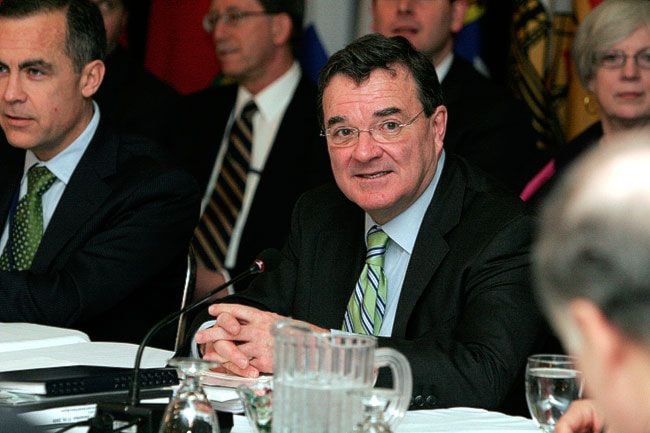“There are 11 million Canadians in this country who have no pension, and if that’s not a crisis, I don’t know what is,” says Hassan Yussuff.
The Canadian Labour Congress secretary-treasurer made the remarks as Finance ministers from across the country arrived in Whitehorse to discuss how to deal with this crisis.
The goal of today’s meeting is to ensure Canadians have enough money for retirement.
The problem hasn’t only been caused by the recent downturn in the economy.
Canadians haven’t been squirreling away enough money for their future.
Many public sector workers have good pensions, but private companies have become reluctant to take on the responsibility of providing employees with a pension.
Even when there is a pension plan, pensioners and long-term disabled workers often lose out when their companies declare bankruptcy.
Under current bankruptcy laws, pensioners are far from first in line when it comes to receiving money from an insolvent business.
When Nortel declared bankruptcy, 25,000 Canadians lost an estimated $1,593 million in after-tax income and health-care benefits.
In BC and Alberta, only 20 per cent of private-sector workers are covered by company pension plans.
If there is no progress today, the two provinces have threatened to create their own public pension fund.
“We believe there is an opportunity to develop a supplemental pension plan - a pan-Canadian plan, not just for British Columbians but for all Canadians,” said BC Finance Minister Colin Hansen.
“If a supplemental CPP top-up or CPP expansion plan are not feasible or achievable at this time, we intend to proceed with plans to develop an alternate plan.”
Hansen wants a broad-based occupational pension plan for private-sector workers.
An approach that supplements the existing Canada Pension Plan and other private savings would be an effective solution for Canadian workers and their families, he said.
Ottawa and Ontario want to examine other options, such as having more Canadians use the private financial services sector to save for retirement.
“We look forward to continuing to work with other provincial and federal governments,” said Alicia Johnston spokesperson for the Ontario Finance Minister’s Office.
“Ontario hopes for some tangible outcomes from the meeting to move forward with the issue.”
The minister would like to move towards a substantive discussion on options and future consultation with relevant groups and stakeholders, said Johnston.
“And we will continue to press the case for a national summit around pensions and retirement income inadequacies.”
The Canadian Labour Council agrees the nation must consider fixes to the pension problem.
But they’d also like to see some action come out of today’s meeting.
“We don’t need any more studies,” said Yussuff. “We just want them to demonstrate more leadership.”
The council laid out its solutions to the problem during a news conference yesterday.
It wants the finance ministers to enhance the Canadian Pension Plan.
The benefit pensioners get out of the plan could easily be doubled by increasing the premium.
“It’s affordable and we already have the infrastructure in place,” said Yussuff. “We don’t need to reinvent the wheel.”
Through the recent recession, the CPP has been able to weather the storm, unlike many private savings plans, he added.
The labour council would also like to see a 50 per cent increase in Canada’s Guaranteed Income Supplement.
The GIS provides additional money, on top of the Old Age Security pension, to low-income seniors throughout Canada.
And to deal with bankruptcy, the labour council would like to see the federal government implement some sort of pension security program.
Only a government-backed insurance program could provide security for retired workers, said Yussuff.
Because even if pensioners were bumped ahead in the bankruptcy line, the assets of the company may not be enough to cover the company’s entire pension liability.
The current system has a pension floor of about $12,000 a year, said Joel Hardon, another member of the Canadian Labour Congress who was in town for today’s meeting.
“That’s a poverty income,” he said.
“You can say that’s not so bad, but what if it was your mom living on $12,000 a year? What if it was you?”
The paltry state of Canada’s pension system was a policy decision, said Hardon.
“We decided to cap public pensions because Bay Street told everyone, ‘We’ll make you rich.’”
But based on the average RRSP holdings, most retirees are only making about $250 a month, on top of that $12,000 a year.
“Our proposal to increase the public plan ensures that pensions don’t get fleeced by the extremely high fees that RRSP has or suffer when the market tanks,” Hardon added.
There are seniors in the Yukon that are living on very little, according to Skip Beese of the Yukon Anti-Poverty Coalition.
“And when you get to a certain age you get into mobility issues and things like that,” he said.
“It becomes hard to stretch the money you’ve got.”
If the Canadian pension system isn’t in crisis, it will be in the near future.
More Canadians are entering retirement every day and very soon 20 per cent of Canadians will be retired, said Yussuff.
“This means that more and more seniors will be living in poverty.”
Contact Chris Oke at
chriso@yukon-news.com
